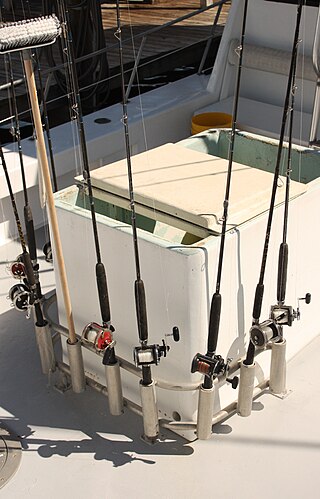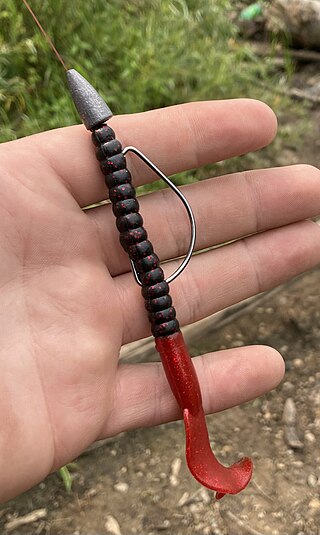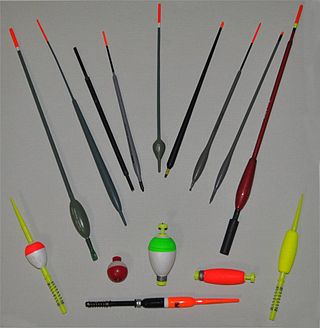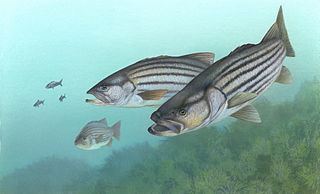
A fishing rod is a long, thin rod used by anglers to catch fish by manipulating a line ending in a hook. At its most basic form, a fishing rod is a straight rigid stick/pole with a line attached to one end ; however, modern rods are usually elastic and generally have the line stored in a reel mounted at the rod handle, which is hand-cranked and controls the line retrieval, as well as numerous line-restricting rings that distribute bending stress along the rod and help dampening down/prevent line whipping and entanglement. To better entice fish, baits or lures are dressed onto the one or more hooks attached to the line, and a bite indicator is used, some of which might be incorporated as part of the rod itself.

A fishing reel is a hand-cranked reel used in angling to wind and stow fishing line, typically mounted onto a fishing rod, but may also be used to retrieve a tethered arrow when bowfishing.

A fishing line is a flexible, high-tensile cord used in angling to tether and pull in fish, in conjunction with at least one hook. Fishing lines are usually pulled by and stored in a reel, but can also be retrieved by hand, with a fixed attachment to the end of a rod, or via a motor.

Fly fishing is an angling technique that uses an ultralight-weight lure called an artificial fly, which typically mimics small invertebrates such as flying and aquatic insects to attract and catch fish. Because the mass of the fly lure is insufficient to overcome air resistance, it cannot be launched far using conventional gears and techniques, so specialized tackles are used instead and the casting techniques are significantly different from other forms of angling. It is also very common for the angler to wear waders, carry a hand net, and stand in the water when fishing.

Angling is a fishing technique that uses a fish hook attached to a fishing line to tether individual fish in the mouth. The fishing line is usually manipulated via a fishing rod, although rodless techniques such as handlining also exist. Modern angling rods are usually fitted with a fishing reel that functions as a cranking device for storing, retrieving and releasing out the line, although Tenkara fishing and traditional cane pole fishing are two rod-angling methods that do not use any reel. The fish hook itself can be additionally weighted with a denser tackle called a sinker, and is typically dressed with an appetizing bait to attract and entice the fish into swallowing the hook, but sometimes an inedible fake/imitation bait with multiple attached hooks is used instead of a single hook with edible bait. Some type of bite indicator, such as a float, a bell or a quiver tip, is often used to relay underwater status of the hook to the surface and alert the angler of a fish's presence.

Catch and release is a practice within recreational fishing where after capture, often a fast measurement and weighing of the fish is performed, followed by posed photography as proof of the catch, and then the fish are unhooked and returned live to the water. Using barbless hooks, it is often possible to release the fish without removing it from the water.

Recreational fishing, also called sport fishing or game fishing, is fishing for leisure, exercise or competition. It can be contrasted with commercial fishing, which is professional fishing for profit; or subsistence fishing, which is fishing for survival and livelihood.

Jigging is the practice of fishing with a jig, a type of weighted fishing lure. A jig consists of a heavy metal sinker with an attached fish hook that is usually obscured inside a soft lure or feather-like decorations. Jigs are intended to create a jerky, vertical "jumping" motion to attract fish, as opposed to other common lures like swimbaits, spoons and spinnerbaits, which move through the water more or less horizontally. The jig is very versatile and can be used in both salt and fresh water. Many deeper water fish species are attracted to the lure, which has made it popular among anglers for years.

A fishing lure is any one of a broad category of artificial angling baits that are inedible replicas designed to mimic prey animals that attract the attention of predatory fish, typically via appearances, flashy colors, bright reflections, movements, vibrations and/or loud noises which appeal to the fish's predation instinct and entice it into gulping the lure. Angling activities using lures are known as lure fishing.

In angling, casting is the act of the angler throwing the bait and hook as well as other attached terminal tackles out over the water, typically by slinging a fishing line manipulated by a long, elastic fishing rod. The term itself may also be used for setting out a net when artisanal fishing.

The Texas rig is a fishing rig used for angling with soft plastic lures. It involves a bullet-shaped weight being threaded onto the fishing line first, that can be followed by a glass or plastic bead, and then the line is secured to a fish hook, usually an offset worm hook. The hook is then inserted into the head region of a worm lure and exits about 1⁄4 inch (6.4 mm) down the worm. The worm is then moved up the hook towards the shank and then rotated so that the worm is now "locked" on the shank. The point of the hook is then threaded back into the body of the worm to make the rig "weedless".

A spinnerbait or spinner is any one of a family of hybrid fishing lures that combines the designs of a swimbait with one or more spoon lure blades. Spinnerbaits get the name from the action of the metallic blades, which passively revolve around the attachment point like a spinning propeller when the lure is in motion, creating varying degrees of vibration and flashing that mimic small fish or other preys of interest to large predatory fishes. The two most popular types of spinnerbaits are the in-line spinner and safety pin spinnerbait, though others such as the tail spinner also exist. Spinnerbaits are used principally for catching freshwater fishes such as perch, pike and bass.

Fishing tackle is the equipment used by anglers when fishing. Almost any equipment or gear used in fishing can be called fishing tackle, examples being hooks, lines, baits/lures, rods, reels, floats, sinkers/feeders, nets, spears, gaffs and traps, as well as wires, snaps, beads, spoons, blades, spinners, clevises and tools that make it easy to tie knots.

Coarse fishing is a phrase commonly used in Britain and Ireland. It refers to the angling for rough fish, which are fish species traditionally considered undesirable as food or game fish. Freshwater game fish are all salmonids, particularly salmon, trout and char. Generally, coarse fish are freshwater fish that are not salmonids, though there is often disagreement over whether grayling should be classified as game fish or a coarse fish.

A fishing float or bobber is a lightweight buoy used in angling, usually attached to a fishing line. Angling using a float is sometimes called float fishing.
In recreational fishing terminology, the hookset or setting the hook is when an angler makes a sudden lifting motion to a fishing rod in order to pull the line and anchor the fish hook firmly into the mouth of a fish once it has gulped in the hook along with the bait/lure.

Striped bass are perciform fish found all along the Atlantic coast, from Florida to Nova Scotia. A distinct strain has historically existed in the Gulf of Mexico, but the fishery that exists there today is for stocked or reservoir-escapee fish. Striped bass are of significant value as sporting fish, and have been introduced to many areas outside their native range.

Fishing techniques are methods for catching fish. The term may also be applied to methods for catching other aquatic animals such as molluscs and edible marine invertebrates.

Fishing bait is any luring substance used specifically to attract and catch fish, typically when angling with a hook and line. There are generally two types of baits used in angling: hookbaits, which are directly mounted onto fish hooks and are what the term "fishing bait" typically refers to; and groundbaits, which are scattered separately into the water as an "appetizer" to attract the fish nearer to the hook. Despite the bait's sole importance is to provoke a feeding response out of the target fish, the way how fish react to different baits is quite poorly understood.
The following outline is provided as an overview of and topical guide to fishing:































